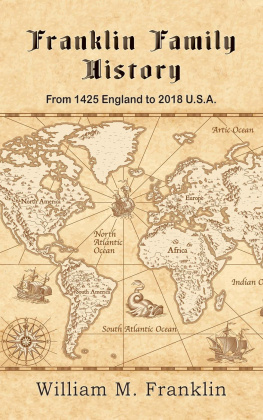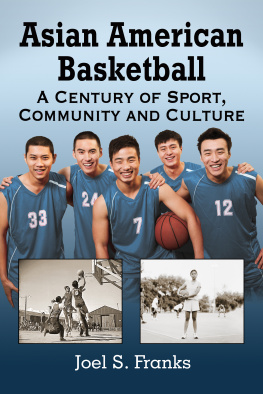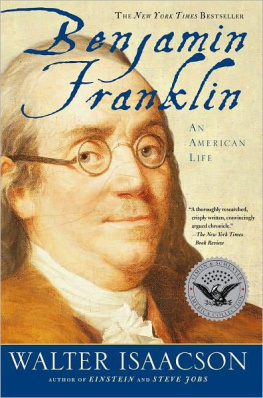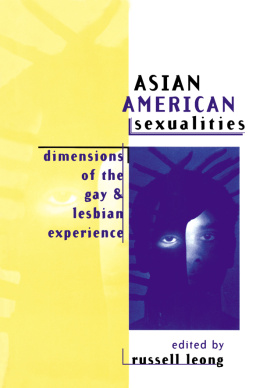Asians in America
The Peoples of East, Southeast, and South Asia in American Life and Culture
Series Editor
Franklin Ng
California State University Fresno
A GARLAND SERIES
Contents of the Series
1. The History and Immigration of Asian Americans
2. Asian American Family Life and Community
3. Asian American Women and Gender
4. Adaptation, Acculturation, and Transnational Ties Among Asian Americans
5. Asian American Interethnic Relations and Politics
6. Asian American Issues Relating to Labor, Economics, and Socioeconomic Status
Asian American Family Life and Community
Edited with introductions by
Franklin Ng
California State University Fresno
First published by Garland Publishing, Inc.
This edition published 2013 by Routledge
Routledge
Taylor & Francis Group
711 Third Avenue
New York, NY 10017
Routledge
Taylor & Francis Group
2 Park Square
Milton Park, Abingdon
Oxon OX14 4RN
Routledge is an imprint of the Taylor & Francis Group, an informa business
Introductions copyright 1998 Franklin Ng. All rights reserved.
Library of Congress Cataloging-in-Publication Data
Asian American family life and community / edited with introductions by Franklin Ng.
p. cm. (Asians in America; 2)
Includes bibliographical references.
ISBN 0-8153-2691-2 (v. 2 : alk. paper). ISBN 0-8153-2689-0 (6 vol. set : alk. paper)
1. Asian American families. 2. Asian AmericansSocial conditions. 3. Asian AmericansEconomic conditions. I. Ng, Franklin, 1947 . II. Series.
E184.06A8275 1998
305.895073dc21
98-10881
CIP
SETISBN | 9780815326892 |
POD ISBN | 9780415895460 |
Vol1 | 9780815326908 |
Vol2 | 9780815326915 |
Vol3 | 9780815326922 |
Vol4 | 9780815326939 |
Vol5 | 9780815326946 |
Vol6 | 9780815326953 |
Contents
Victor Nee and Herbert Y. Wong
Nazli Kibria
Colleen Leahy Johnson
Colleen Leahy Johnson
Anne K. Fleuret
Jonathan Y. Okamura
Elena S.H. Yu
Ivan Light, Im Jung Kwuon, and Deng Zhong
Sue Fawn Chung
George M. Scott Jr.
David W. Haines
Kenneth A. Skinner
Bernard Wong
Jonathan Y. Okamura
Pyong Gap Min
As the fastest growing segment of the U.S. population since the mid-1960s, Asian Americans encompass Chinese, Japanese, Koreans, Filipinos, Asian Indians, Pakistanis, Sri Lankans, Bangladeshis, Vietnamese, Lao, Hmong, Cambodians, Iu-Mien, and others. Their remarkably diverse ethnic, social, historical, and religious backgrounds and experiences enrich the cultural fabric of the United States. The study of Asian Americans offers many insights on such issues as immigration, refugee policy, transnationalism, return migration, cultural citizenship, ethnic communities, community building, identity and group formation, panethnicity, race relations, gender and class, entrepreneurship, employment, representation, politics, adaptation, and acculturation.
This collection of articles presents contemporary research that examines such issues as the growing political power of Asian Americans, the empowerment of emigrant women, the rise of youth gangs, relations between ethnic groups, the migration of highly educated Asians, and other important subjects. The writings are drawn from a wide variety of disciplines to provide a broad but informative array of insights on this fascinating and diverse population. The volumes give in-depth exposure to important issues linked to the different communities and impart a greater understanding of Asian Americans in the United States.
This series consists of six volumes, and its coverage cuts across many disciplines. The first volume focuses on the history and immigration of Asian Americans. The second volume treats various themes relating to Asian American family life and community. The third volume is complementary and considers vital issues pertaining to Asian American women and gender. A fourth volume explores the processes of adaptation and acculturation, as well as the continuing significance of transnational ties for Asian Americans. The fifth volume addresses the complex subject of interethnic relations and Asian American politics. Finally, the last volume examines issues associated with labor, employment, entrepeneurship, enclave economies, and socioeconomic status.
In preparing this anthology, I have had help from many individuals. I would especially like to acknowledge assistance from Leo Balk, Paul Finkelman, and Carole Puccino. Their patience, encouragement, and guidance helped to ensure the success of this project.
Families constitute the building blocks of communities and are an important aspect of the Asian American experience. In the migration to the United States, Asian families had to wrestle with traditional ideas of socialization as opposed to the changes that came with the adjustment to the new environment. Families became the sites for the negotiation of issues pertaining to cultural values, enculturation, and economic activity. Immigration policies set forth by the United States and the cultural practices of the immigrant homeland also affected the nature of the families that were transplanted.
Given the diversity of Asian groups that came to the United States, there were to be a variety of Asian families over time. Restrictive immigration laws before World War II, for example, helped to ensure a predominance of men versus women in the Chinese, Filipino, and Asian Indian communities. This resulted in the appearance of bachelor communities for the Chinese and Filipinos. In locales where there were no antimiscegenation laws, intermarriage was an option. Many Asian Indians married Mexican women in California, Filipinos married European immigrant women in Illinois, and Chinese married native women in Hawaii. The immigration barriers also helped to promote split household families among some Chinese and Asian Indians. In this case, the male spouse labored in the United States while the female counterpart resided in the immigrant homeland. Remittances were sent across the Pacific to support the wives and family members. Japanese male immigrants, in contrast, formed families by sending for picture brides as did some Koreans.
Major changes among Asian American families and communities occurred after 1965 and after the Vietnam War. This volume takes note of these changes and examines issues such as the role of the family, generational changes, and the significance of kinship, networks, newspapers, and credit associations in various Asian American groups.
Families are often seen as a key element behind the success of Asian immigrant achievement. Going beyond the cultural factors versus opportunity structures debate, Victor Nee and Herbert Wong try to account for socioeconomic mobility of the Chinese and the Japanese in America. Public policy does have an impact upon families in the United States, especially for the refugees from the Vietnam War. However, David W. Haines notes that federal policy is not aware of the importance of kinship for Southeast Asians and how it can impact their economic adjustment and bases of social support. Nazli Kibria indicates how household structure and family ideology play a critical role in how the Vietnamese adapt economically. By emphasizing family collectivism, the Vietnamese devise strategies by which they can share economic and social resources. Kenneth A. Skinner follows by pointing out that Vietnamese youth, women, and others may have diversity in their adaptation to America. Finally, in the Asian American population, Japanese Americans are the only group that is primarily American-born in composition. Colleen Johnson explains how social mechanisms help to reinforce the solidarity of extended family structures among Japanese Americans. In another article, she discusses how the concept of generation is linked with ethnicity for Japanese Americans.












